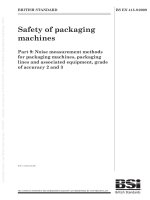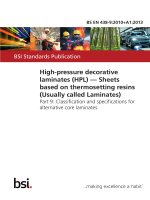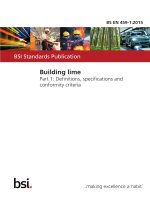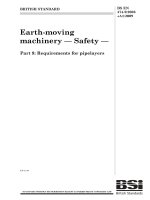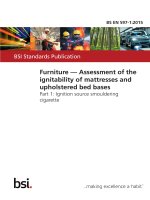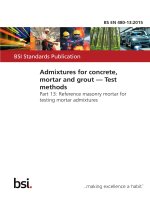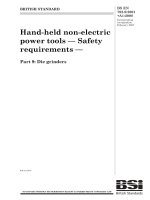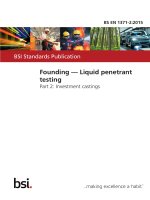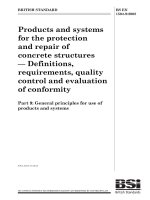Bsi bs en 61557 9 2015
Bạn đang xem bản rút gọn của tài liệu. Xem và tải ngay bản đầy đủ của tài liệu tại đây (1.4 MB, 32 trang )
BS EN 61557-9:2015
BSI Standards Publication
Electrical safety in low
voltage distribution systems
up to 1 000 V a.c. and
1 500 V d.c. — Equipment
for testing, measuring or
monitoring of protective
measures
Part 9: Equipment for insulation fault
location in IT systems
BRITISH STANDARD
BS EN 61557-9:2015
National foreword
This British Standard is the UK implementation of EN 61557-9:2015. It
is identical to IEC 61557-9:2014. It supersedes BS EN 61557-9:2009
which is withdrawn.
The UK participation in its preparation was entrusted to Technical
Committee PEL/85, Measuring equipment for electrical and
electromagnetic quantities.
A list of organizations represented on this committee can be obtained on
request to its secretary.
This publication does not purport to include all the necessary provisions of
a contract. Users are responsible for its correct application.
© The British Standards Institution 2015.
Published by BSI Standards Limited 2015
ISBN 978 0 580 81263 7
ICS 17.220.20; 25.040.40; 29.080.01
Compliance with a British Standard cannot confer immunity from
legal obligations.
This British Standard was published under the authority of the
Standards Policy and Strategy Committee on 28 February 2015.
Amendments/corrigenda issued since publication
Date
Text affected
EUROPEAN STANDARD
EN 61557-9
NORME EUROPÉENNE
EUROPÄISCHE NORM
February 2015
ICS 25.040.40
Supersedes EN 61557-9:2009
English Version
Electrical safety in low voltage distribution systems up to 1 000 V
a.c. and 1 500 V d.c. - Equipment for testing, measuring or
monitoring of protective measures - Part 9: Equipment for
insulation fault location in IT systems
(IEC 61557-9:2014)
Sécurité électrique dans les réseaux de distribution basse
tension de 1 000 V c.a. et 1 500 V c.c - Dispositifs de
contrôle, de mesure ou de surveillance de mesures de
protection - Partie 9: Dispositifs de localisation de défauts
d'isolement pour réseaux IT
(IEC 61557-9:2014)
Elektrische Sicherheit in Niederspannungsnetzen bis AC 1
000 V und DC 1 500 V - Geräte zum Prüfen, Messen oder
Überwachen von Schutzmaßnahmen - Teil 9: Einrichtungen
zur Isolationsfehlersuche in IT-Systemen
(IEC 61557-9:2014)
This European Standard was approved by CENELEC on 2015-01-15. CENELEC members are bound to comply with the CEN/CENELEC
Internal Regulations which stipulate the conditions for giving this European Standard the status of a national standard without any alteration.
Up-to-date lists and bibliographical references concerning such national standards may be obtained on application to the CEN-CENELEC
Management Centre or to any CENELEC member.
This European Standard exists in three official versions (English, French, German). A version in any other language made by translation
under the responsibility of a CENELEC member into its own language and notified to the CEN-CENELEC Management Centre has the
same status as the official versions.
CENELEC members are the national electrotechnical committees of Austria, Belgium, Bulgaria, Croatia, Cyprus, the Czech Republic,
Denmark, Estonia, Finland, Former Yugoslav Republic of Macedonia, France, Germany, Greece, Hungary, Iceland, Ireland, Italy, Latvia,
Lithuania, Luxembourg, Malta, the Netherlands, Norway, Poland, Portugal, Romania, Slovakia, Slovenia, Spain, Sweden, Switzerland,
Turkey and the United Kingdom.
European Committee for Electrotechnical Standardization
Comité Européen de Normalisation Electrotechnique
Europäisches Komitee für Elektrotechnische Normung
CEN-CENELEC Management Centre: Avenue Marnix 17, B-1000 Brussels
© 2015 CENELEC All rights of exploitation in any form and by any means reserved worldwide for CENELEC Members.
Ref. No. EN 61557-9:2015 E
BS EN 61557-9:2015
EN 61557-9:2015
-2-
Foreword
The text of document 85/486/FDIS, future edition 3 of IEC 61557-9, prepared by IEC/TC 85 "Measuring
equipment for electrical and electromagnetic quantities" was submitted to the IEC-CENELEC parallel vote
and approved by CENELEC as EN 61557-9:2015.
The following dates are fixed:
•
latest date by which the document has to be
implemented at national level by
publication of an identical national
standard or by endorsement
(dop)
2015-10-15
•
latest date by which the national
standards conflicting with the
document have to be withdrawn
(dow)
2018-01-15
This document supersedes EN 61557-9:2009
Attention is drawn to the possibility that some of the elements of this document may be the subject of patent
rights. CENELEC [and/or CEN] shall not be held responsible for identifying any or all such patent rights.
This standard covers the Principle Elements of the Safety Objectives for Electrical Equipment Designed for
Use within Certain Voltage Limits (LVD).
Endorsement notice
The text of the International Standard IEC 61557-9:2014 was approved by CENELEC as a European
Standard without any modification.
In the official version, for Bibliography, the following notes have to be added for the standards indicated:
IEC 60364-4-41:2005
NOTE
Harmonized as HD 60364-4-41:2007.
IEC 60664-1
NOTE
Harmonized as EN 60664-1.
IEC 60664-3
NOTE
Harmonized as EN 60664-3.
IEC 60947-5-1:2003
NOTE
Harmonized as EN 60947-5-1:2004.
IEC 60947-5-4:2002
NOTE
Harmonized as EN 60947-5-4:2003.
IEC 61140
NOTE
Harmonized as EN 61140.
IEC 61810-2:2011
NOTE
Harmonized as EN 61810-2:2011.
-3-
BS EN 61557-9:2015
EN 61557-9:2015
Annex ZA
(normative)
Normative references to international publications
with their corresponding European publications
The following documents, in whole or in part, are normatively referenced in this document and are
indispensable for its application. For dated references, only the edition cited applies. For undated
references, the latest edition of the referenced document (including any amendments) applies.
NOTE 1 When an International Publication has been modified by common modifications, indicated by (mod), the relevant EN/HD
applies.
NOTE 2 Up-to-date information on the latest versions of the European Standards listed in this annex is available here:
www.cenelec.eu.
Publication
IEC 60068-2-1
Year
-
IEC 60068-2-2
-
IEC 60068-2-6
-
IEC 60068-2-27
-
IEC 60364-7-710
(mod)
2002
IEC 60529
-
IEC 60664
series
IEC 60721-3-1
-
IEC 60721-3-2
-
IEC 60721-3-3
-
IEC 61010-1
2010
IEC 61010-2-030
-
IEC 61010-2-032
-
Title
EN/HD
Environmental testing -- Part 2-1: Tests - Test EN 60068-2-1
A: Cold
Environmental testing -- Part 2-2: Tests - Test EN 60068-2-2
B: Dry heat
Environmental testing -- Part 2-6: Tests - Test EN 60068-2-6
Fc: Vibration (sinusoidal)
Environmental testing -- Part 2-27: Tests EN 60068-2-27
Test Ea and guidance: Shock
Electrical installations of buildings -- Part 7- HD 60364-7-710
710: Requirements for special installations or
locations - Medical locations
+AC
Degrees of protection provided by enclosures (IP Code)
Insulation coordination for equipment within EN 60664
low-voltage systems
Classification of environmental conditions -- EN 60721-3-1
Part 3: Classification of groups of
environmental parameters and their severities
-- Section 1: Storage
Classification of environmental conditions -- EN 60721-3-2
Part 3: Classification of groups of
environmental parameters and their severities
-- Section 2: Transportation
Classification of environmental conditions -- EN 60721-3-3
Part 3: Classification of groups of
environmental parameters and their severities
-- Section 3: Stationary use at
weatherprotected locations
Safety requirements for electrical equipment EN 61010-1
for measurement, control and laboratory use - Part 1: General requirements
Safety requirements for electrical equipment EN 61010-2-030
for measurement, control and laboratory use - Part 2-030: Particular requirements for
testing and measuring circuits
Safety requirements for electrical equipment EN 61010-2-032
for measurement, control, and laboratory use
-- Part 2-032: Particular requirements for
hand-held and hand-manipulated current
sensors for electrical test and measurement
Year
2012
2013
series
-
-
-
2010
-
-
BS EN 61557-9:2015
EN 61557-9:2015
-4-
IEC 61010-031
-
IEC 61326-2-2
-
IEC 61326-2-4
-
IEC 61557-1
2007
IEC 61557-8
-
CISPR 11
-
Safety requirements for electrical equipment EN 61010-031
for measurement, control and laboratory use - Part 031: Safety requirements for hand-held
probe assemblies for electrical measurement
and test
Electrical equipment for measurement, controlEN 61326-2-2
and laboratory use - EMC requirements -Part 2-2: Particular requirements - Test
configurations, operational conditions and
performance criteria for portable test,
measuring and monitoring equipment used in
low-voltage distribution systems
Electrical equipment for measurement, controlEN 61326-2-4
and laboratory use - EMC requirements -Part 2-4: Particular requirements - Test
configurations, operational conditions and
performance criteria for insulation monitoring
devices according to IEC 61557-8 and for
equipment for insulation fault location
according to IEC 61557-9
Electrical safety in low voltage distribution
EN 61557-1
systems up to 1 000 V a.c. and 1 500 V d.c. Equipment for testing, measuring or
monitoring of protective measures -- Part 1:
General requirements
Electrical safety in low voltage distribution
EN 61557-8
systems up to 1 000 v a.c. And 1 500 v d.c. Equipment for testing, measuring or
monitoring of protective measures -- Part 8:
insulation monitoring devices for it systems
Industrial, scientific and medical equipment - EN 55011
Radio-frequency disturbance characteristics Limits and methods of measurement
-
-
-
2007
-
-
–2–
BS EN 61557-9:2015
IEC 61557-9:2014 © IEC 2014
CONTENTS
1
Scope .............................................................................................................................. 7
2
Normative references ...................................................................................................... 7
3
Terms, definitions and abbreviations ............................................................................... 8
3.1
Terms, definitions, symbols and units ..................................................................... 8
3.2
Abbreviations ........................................................................................................ 10
4
Requirements ................................................................................................................ 10
4.1
General requirements ........................................................................................... 10
4.2
Mandatory functions provided by an IFLS ............................................................. 11
4.2.1
Location warning ........................................................................................... 11
4.2.2
Local location warning (LLW) ......................................................................... 11
4.2.3
Remote location warning (RLW)..................................................................... 11
Optional functions provided by IFLS ...................................................................... 12
4.3
4.3.1
Indication of the insulation value .................................................................... 12
4.3.2
Performance of the IFLS in case of the interruption of the connection to
the locating current sensor (LCS) .................................................................. 12
4.4
Performance requirements .................................................................................... 12
4.4.1
Response sensitivity ...................................................................................... 12
4.4.2
Locating current I L ........................................................................................ 12
4.4.3
Locating voltage U L ....................................................................................... 12
Electromagnetic compatibility (EMC) ..................................................................... 12
4.5
4.6
Safety requirements .............................................................................................. 12
4.6.1
General ......................................................................................................... 12
4.6.2
Clearances and creepage distances .............................................................. 12
4.6.3
Protection class and earth connection of the IFLS ......................................... 13
Climatic environmental conditions ......................................................................... 13
4.7
4.8
Mechanical requirements ...................................................................................... 13
4.8.1
General ......................................................................................................... 13
4.8.2
Product mechanical robustness ..................................................................... 13
4.8.3
IP protection class requirements .................................................................... 14
Marking and operating instructions ................................................................................ 15
5
5.1
Marking ................................................................................................................. 15
5.2
Operating instructions ........................................................................................... 15
6
Tests ............................................................................................................................. 16
6.1
General ................................................................................................................. 16
6.2
Type tests ............................................................................................................. 16
6.2.1
General ......................................................................................................... 16
6.2.2
Test of response sensitivity of the IFLS ......................................................... 16
6.2.3
Test of the locating current I L ........................................................................ 17
6.2.4
Test of the locating voltage U L ...................................................................... 17
6.2.5
Test of the location warning ........................................................................... 17
6.2.6
Test of the indication of the insulation value .................................................. 17
6.2.7
Test of the performance of the LCI ................................................................ 17
6.2.8
Voltage test ................................................................................................... 17
6.2.9
Test of the electromagnetic compatibility (EMC) ............................................ 18
6.2.10
Test of the loss of LCS connection ................................................................ 18
BS EN 61557-9:2015
IEC 61557-9:2014 © IEC 2014
–3–
6.2.11
Test of the protection class and the earth connection of the IFLS .................. 18
6.2.12
Inspection of the marking and operating instructions ...................................... 18
6.2.13
Mechanical test ............................................................................................. 18
6.2.14
Record of the type test .................................................................................. 18
Routine tests......................................................................................................... 18
6.3
6.3.1
General ......................................................................................................... 18
6.3.2
Test of the response sensitivity...................................................................... 18
6.3.3
Test of the location warning ........................................................................... 19
6.3.4
Test of the self-test function .......................................................................... 19
6.3.5
Voltage test ................................................................................................... 19
6.3.6
Compliance with the tests of Clause 6 ........................................................... 19
Overview of requirements and tests for IFLSs ................................................................ 19
7
Annex A (normative) Equipment for insulation fault location in medical locations ................. 20
A.1
Scope ................................................................................................................... 20
A.2
Requirements ....................................................................................................... 20
A.2.1
General ......................................................................................................... 20
A.2.2
Performance requirements ............................................................................. 20
A.2.3
Electromagnetic compatibility (EMC) ............................................................. 20
A.3
Marking and operating instructions ........................................................................ 20
A.4
Tests .................................................................................................................... 21
A.4.1
General ......................................................................................................... 21
A.4.2
Type tests ...................................................................................................... 21
Annex B (normative) Portable equipment for insulation fault location ................................... 22
B.1
Scope ................................................................................................................... 22
B.2
Requirements ....................................................................................................... 22
B.2.1
General ......................................................................................................... 22
B.2.2
Performance requirements ............................................................................. 22
B.3
Marking and operating instructions ........................................................................ 22
B.4
Tests .................................................................................................................... 22
Annex C (informative) Example of an IFLS and explanation of upstream and
downstream system leakage capacitances ............................................................................ 24
C.1
Examples of an IFLS ............................................................................................. 24
C.2
Upstream and downstream system leakage capacitance ....................................... 26
Bibliography .......................................................................................................................... 27
Figure C.1 – Example of an IFLS .......................................................................................... 25
Figure C.2 – Explanation of upstream and downstream system leakage capacitance ........... 26
Table 1 – Abbreviations ........................................................................................................ 10
Table 2 – Product mechanical requirements .......................................................................... 14
Table 3 – Minimum IP requirements for IFLS ........................................................................ 15
Table 4 – Reference conditions for tests in operation ............................................................ 16
Table 5 – Reference conditions for storage tests .................................................................. 16
Table 6 – Requirements and tests on IFLSs .......................................................................... 19
–4–
BS EN 61557-9:2015
IEC 61557-9:2014 © IEC 2014
Table A.1 – Additional requirements applicable to equipment for insulation fault
location in medical locations ................................................................................................. 21
Table A.2 – Emission test for equipment for insulation fault location in medical
locations ............................................................................................................................... 21
BS EN 61557-9:2015
IEC 61557-9:2014 © IEC 2014
–7–
ELECTRICAL SAFETY IN LOW VOLTAGE DISTRIBUTION SYSTEMS UP
TO 1 000 V AC AND 1 500 V DC – EQUIPMENT FOR TESTING, MEASURING
OR MONITORING OF PROTECTIVE MEASURES –
Part 9: Equipment for insulation fault location in IT systems
1
Scope
This part of IEC 61557 specifies the requirements for the insulation fault location system
(IFLS) which localizes insulation faults in any part of the system in unearthed IT a.c. systems
and unearthed IT a.c. systems with galvanically connected d.c. circuits having nominal
voltages up to 1 000 V a.c., as well as in unearthed IT d.c. systems with voltages up to
1 500 V d.c., independent of the measuring principle.
IT systems are described in IEC 60364-4-41 amongst other literature. Additional data for a
selection of devices in other standards should be noted.
NOTE Further information on insulation fault location
IEC 60364-4-41:2005, 411.6, and IEC 60364-5-53:2001, 531.3.
2
can
be
found
in
the
following
standards:
Normative references
The following documents, in whole or in part, are normatively referenced in this document and
are indispensable for its application. For dated references, only the edition cited applies. For
undated references, the latest edition of the referenced document (including any
amendments) applies.
IEC 60068-2-1, Environmental testing – Part 2-1: Tests – Test A: Cold
IEC 60068-2-2, Environmental testing – Part 2-2: Tests – Test B: Dry heat
IEC 60068-2-6, Environmental testing – Part 2-6: Tests – Test Fc: Vibration (sinusoidal)
IEC 60068-2-27, Environmental testing – Part 2-27: Tests – Test Ea and guidance: Shock
IEC 60364-7-710:2002, Electrical installations of buildings – Part 7-710: Requirements for
special installations or locations – Medical locations
IEC 60529, Degree of protection provided by enclosures (IP Code)
IEC 60664 (all parts): Insulation coordination for equipment within low-voltage systems
IEC 60721-3-1, Classification of environmental conditions – Part 3: Classification of groups of
environmental parameters and their severities – Section 1: Storage
IEC 60721-3-2, Classification of environmental conditions – Part 3: Classification of groups of
environmental parameters and their severities – Section 2: Transportation
IEC 60721-3-3, Classification of environmental conditions – Part 3-3: Classification of groups
of environmental parameters and their severities – Stationary use at weatherprotected
locations
–8–
BS EN 61557-9:2015
IEC 61557-9:2014 © IEC 2014
IEC 61010-1:2010, Safety requirements for electrical equipment for measurement, control,
and laboratory use – Part 1: General requirements
IEC 61010-2-030, Safety requirements for electrical equipment for measurement, control, and
laboratory use – Part 2-030: Particular requirements for testing and measuring circuits
IEC 61010-031, Safety requirements for electrical equipment for measurement, control and
laboratory use – Part 031: Safety requirements for hand-held probe assemblies for
measurement and test
IEC 61010-2-032, Safety requirements for electrical equipment for measurement, control, and
laboratory use – Part 2-032: Particular requirements for hand-held and hand-manipulated
current sensors for electrical test and measurement
IEC 61326-2-2, Electrical equipment for measurement, control and laboratory use – EMC
requirements – Part 2-2: Particular requirements – Test configurations, operational conditions
and performance criteria for portable test, measuring and monitoring equipment used in lowvoltage distribution systems
IEC 61326-2-4, Electrical equipment for measurement, control and laboratory use – EMC
requirements – Part 2-4: Particular requirements – Test configurations, operational conditions
and performance criteria for insulation monitoring devices according to IEC 61557-8 and for
equipment for insulation fault location according to IEC 61557-9
IEC 61557-1:2007, Electrical safety in low voltage distribution systems up to 1 000 V a.c. and
1 500 V d.c. – Equipment for testing, measuring or monitoring of protective measures – Part 1:
General requirements
IEC 61557-8, Electrical safety in low voltage distribution systems up to 1 000 V a.c. and
1 500 V d.c. – Equipment for testing, measuring or monitoring of protective measures – Part 8:
Insulation monitoring devices for IT systems
CISPR 11, Industrial, scientific and medical equipment - Radio-frequency disturbance
characteristics - Limits and methods of measurement
3
3.1
Terms, definitions and abbreviations
Terms, definitions, symbols and units
For the purposes of this document, the terms and definitions given in IEC 61557-1 and
IEC 61557-8 and the following apply.
3.1.1
insulation fault location system
IFLS
device or combination of devices used for insulation fault location in IT systems, where the
insulation fault location system is used in addition to an insulation monitoring device and is
used to locate insulation faults
Note 1 to entry:
An IFLS injects a locating current between the electrical system and earth.
3.1.2
locating current
IL
r.m.s. value of the current that is injected by the locating current injector during the location
process. The locating current can be generated by
–
an independent locating voltage source, or
BS EN 61557-9:2015
IEC 61557-9:2014 © IEC 2014
–9–
–
an independent locating current source, or
–
it can be driven directly from the system to be monitored
3.1.3
locating voltage
UL
r.m.s. value of the voltage present at the measuring terminals of the locating current injector
during the measurement when the device has an independent locating voltage or current
source
Note 1 to entry: In a fault-free, de-energized system, this represents the voltage present between the terminals of
the locating device to the system to be monitored and the terminals for the connection to the PE conductor.
3.1.4
response sensitivity
value of the evaluating current or insulation resistance at which the evaluator responds under
specified conditions
Note 1 to entry:
Response sensitivity can either be a fixed threshold or a response curve.
3.1.5
insulation fault locator
device or part of a device for the location of the insulation fault
3.1.6
locating current sensor
sensor for the detection of the locating current used for the location of the insulation fault
3.1.7
locating current injector
device or part of a device, which function it is to inject the locating current in the IT system in
order to locate the insulation fault
3.1.8
passive locating current injector
locating current injector that generates the locating current directly from the system to be
monitored
3.1.9
active locating current injector
locating current injector that generates the locating current from a locating voltage source
which is independent from the system to be monitored
3.1.10
equipment for insulation fault location in medical locations
specific insulation fault location equipment dedicated to locating insulations faults in IT
systems of group 2 medical locations complying with Annex A
3.1.11
response time
t al
time required by insulation fault location equipment to respond under the conditions of A.2.2.1
3.1.12
group 2 medical locations
medical locations, where applied parts are intended to be used in applications such as
intracardiac procedures, operating theatres and vital treatment, where discontinuity (failure) of
the supply can cause danger to life
BS EN 61557-9:2015
IEC 61557-9:2014 © IEC 2014
– 10 –
Note 1 to entry: An intracardiac procedure is a procedure, whereby an electrical conductor is placed within the
cardiac zone of a patient or is likely to come into contact with the heart, such conductor being accessible outside
the patient's body. In this context, an electrical conductor includes insulated wires, such as cardiac pacing
electrodes or intracardiac ECG-electrodes, or insulated tubes filled with conducting fluids.
[SOURCE: IEC 60364-7-710:2002, 710.3.7]
3.1.13
portable equipment for insulation fault location
equipment used for temporary insulation fault location in IT systems instead of, or additionally,
to fixed installed insulation fault location equipment
3.2
Abbreviations
For the purposes of this document, the terms and abbreviations given in Table 1 apply.
Table 1 – Abbreviations
Abbreviation
Term
Clause
(in this part 9)
C Ld
System leakage capacitance
downstream of the evaluating current
sensor
Figure C.2
C Lu
System leakage capacitance upstream
of the evaluating current sensor
Figure C.2
EMC
Electromagnetic Compatibility
FE
Functional Earth
IFL
Insulation Fault Locator
IFLS
Insulation Fault Location System
IL
Locating current
IMD
Insulation Monitoring Device
IP
Degree of protection of enclosure
LCI
Locating Current Injector
3.1.7, C.2
LCS
Locating Current Sensor
3.1.6, C.1
LLW
Local Location Warning
4.2.2
PE
Protective Earth
4.6.3
PIFL
Portable Insulation Fault Locator
Annex C
PLCS
Portable Locating Current Sensor
B.2.2.1
RF
Insulation resistance
RLW
Remote Location Warning
T
Transformer in an IT system
4
4.1
Other referenced standard
4.5
IEC 60050-161:1990, 161-0107
4.6.3
IEC 61010-1
3.1.5, C.1
3.1.1, Annex C
4.4.2, C.1
Annex C
IEC 61557-8, 3.1.14
4.8.3
IEC 60050-246:2008, 426-0402
6.2.2, C.2
IEC 60050-195:1998,
195-02-09
IEC 61557-8, 3.1.2
4.2.3
Annex C
Requirements
General requirements
In addition to the requirements of Clause 4 of IEC 61557-1:2007, the requirements of
Clause 4 apply.
BS EN 61557-9:2015
IEC 61557-9:2014 © IEC 2014
– 11 –
Equipment for insulation fault location shall be capable of localizing symmetrical as well as
asymmetrical insulation faults in an IT system and to give a location warning, if the insulation
resistance in a part of the installation falls below the response sensitivity.
If equipment for insulation fault location has a self-test function, the self-test shall not produce
an insulation fault to earth.
NOTE 1
See also IEC 61557-8.
NOTE 2
Insulation monitoring devices (IMDs) can be deactivated during the location process.
NOTE 3
Warning indication can be done by a lamp, a buzzer or by any other kind of indication.
NOTE 4
An IFLS can have a self-test function. Checking the response sensitivity is not necessary.
NOTE 5 An IFLS with an active locating current source can also be used for insulation fault location in deenergized systems.
4.2
4.2.1
Mandatory functions provided by an IFLS
Location warning
An IFLS shall contain a visual warning device, which indicates if an insulation fault is detected
or allow connection to such a device for the indication of a fault. If externally connectable
audible signalling devices are provided, they may be fitted with a resetting facility. In this case,
after clearing a fault or resetting the device, the audible signal shall sound if a new fault
occurs. The location warning shall be either a local location warning or a remote location
warning or both together.
4.2.2
Local location warning (LLW)
This functions aims at issuing a warning signal when the insulation resistance between the
system and earth falls below the response sensitivity.
This function will include the localization of an insulation fault in an IT system including
symmetrical and asymmetrical insulation faults, an assessment of this fault and a local
warning.
A local warning should be made by visual indicators or audible signals generated by the
product implementing the function.
NOTE
Usually this function is provided by the IFLS.
4.2.3
Remote location warning (RLW)
This functions aims at issuing a remote warning signal if the insulation resistance between the
system and earth falls below the response sensitivity.
This function will include the localization of an insulation fault in an IT system including
symmetrical and asymmetrical insulation faults, an assessment of this fault and a remote
warning.
A relay contact output or an electronic switching output or a data communication can be used
to report the warning remotely.
NOTE
The warning output could also be used in some applications for switching.
– 12 –
4.3
4.3.1
BS EN 61557-9:2015
IEC 61557-9:2014 © IEC 2014
Optional functions provided by IFLS
Indication of the insulation value
When an IFLS includes means for the indication of the insulation value, the uncertainty of the
indicated value shall be stated by the manufacturer.
4.3.2
Performance of the IFLS in case of the interruption of the connection to the
locating current sensor (LCS)
If provided an indication if the connection to one or more LCSs is lost in a manner that the
location function is not ensured shall be issued.
4.4
4.4.1
Performance requirements
Response sensitivity
An IFLS shall be designed in such a manner that the response sensitivity stated by the
manufacturer will be met under the specified system conditions, at a total symmetrical system
leakage capacitance of 1 µF upstream the evaluating current sensor (C Lu = 1 µF, C Ld = 0 µF
according to Figure C.2).
Information on the influence of the system leakage capacitances higher than 1 µF on the
response sensitivity as well as possible interference from the distribution system on the
insulation fault location process shall be stated by the manufacturer.
NOTE The system leakage capacitance is the sum of the leakage capacitances of all phase conductors, including
the neutral conductor to PE.
4.4.2
Locating current I L
The maximum locating current I L shall be limited to 500 mA r.m.s., to ensure that the locating
current does not produce touch voltages above the conventional voltage limit (50 V a.c.,
120 V d.c.) under the first fault in the distribution system. The locating current shall not
increase above 500 mA r.m.s., under foreseeable component failures in the locating current
injector (LCI). When the locating current is adjustable, unintentional changes of the setting
shall be prevented by suitable means.
4.4.3
Locating voltage U L
If an active locating voltage or locating current is used, the locating voltage U L shall be equal
or below 50 V a.c. or 120 V d.c. (see IEC 60364-4-41) under no load conditions.
If an active locating voltage U L above 50 V a.c. or 120 V d.c. is used the locating current shall
not exceed 3,5 mA a.c. (r.m.s.) or 10 mA d.c. through a pure resistance of 2 000 Ω.
4.5
Electromagnetic compatibility (EMC)
An IFLS shall comply with the EMC requirements in accordance with IEC 61326-2-4.
4.6
4.6.1
Safety requirements
General
In addition to the safety requirements of IEC 61010-1 and IEC 61010-2-030 the following
safety requirements apply.
4.6.2
Clearances and creepage distances
An IFLS shall have minimum clearances and creepage distances in accordance with
IEC 61010-1 and IEC 61010-2-030.
BS EN 61557-9:2015
IEC 61557-9:2014 © IEC 2014
– 13 –
Clearances and creepage distances for fixed installed equipment according to Table 3 can be
dimensioned in accordance with IEC 60664 series.
Clearances and creepage distances shall be selected for:
–
overvoltage or measuring category III or II, depending on the overvoltage or measuring
category in the system to be monitored;
–
pollution degree 2.
NOTE
Pollution degree 3 can be used for accessible parts on the outside of the housing.
A division into circuits with different nominal insulation voltages is permissible in device
combinations for example for IT systems with nominal voltages U n higher than 1 000 V a.c.
and 1 500 V d.c., when the electrical connection is made via resistive, capacitive or inductive
voltage dividers and if, in the case of a fault, the occurrence of inadmissibly high touch
voltages or inadmissibly high currents to earth are prevented by circuit design features. Such
circuit design features (see IEC 61140) can be, for example, additionally provided in the form
of reliable voltage dividers or a duplication of the resistors (protective impedance) in the
voltage divider.
4.6.3
Protection class and earth connection of the IFLS
Contrary to IEC 61557-1, the PE connection of an IFLS (LCI) is a measuring connection and
shall be treated as functional earth connection (FE). If the IFLS has accessible parts which
are earthed for protective purposes, these connections shall be treated as protective earth
connections (PE).
4.7
Climatic environmental conditions
The IFLS shall operate at least under the following climatic conditions:
–
operation: class 3K5 according to IEC 60721-3-3, -5 °C to +45 °C, except condensation
and formation of ice,
–
transport: class 2K3 according to IEC 60721-3-2, -25 °C to +70 °C,
–
storage: class 1K4 according to IEC 60721-3-1, -25 °C to +55 °C.
4.8
4.8.1
Mechanical requirements
General
Instead of the requirements of 4.10 of IEC 61557-1:2007 the requirements of 4.8.2 and 4.8.3
apply.
4.8.2
Product mechanical robustness
Requirements of Table 2 shall be tested as type-tests.
– 14 –
BS EN 61557-9:2015
IEC 61557-9:2014 © IEC 2014
Table 2 – Product mechanical requirements
Mechanical robustness, in
operation test
Behaviour to vibrations
Standard and level
IEC 60068-2-6
Test Fc
Test parameters
2 Hz to 13,2 Hz- amplitude
± 1 mm
13,2 Hz to 100 Hz –
acceleration ± 0,7 g.
For severe vibration
conditions such as e.g.
diesel engines, air
compressors etc.:
2,0 Hz to 25,0 Hz –
amplitude ± 1.6 mm
25,0 Hz to 100 Hz –
acceleration ± 4 g
NOTE More severe
conditions may exist for
example on exhaust
manifolds of diesel engines
especially for medium and
high speed engines Values
may be required to be in
these cases 40 Hz to
2 000 Hz – acceleration
± 10,0g at 600 °C, duration
90 min.
Other information
Duration in case of no
resonance condition 9 min
at 30 Hz.
Duration at each resonance
frequency at which Q ≥ 2 is
recorded – 90 min.
During the vibration test,
functional tests are to be
carried out.
Tests to be carried out in
three mutually
perpendicular planes.
As a guide, it is
recommended that Q does
not exceed 5.
Where a sweep test is to be
carried out instead of the
discrete frequency test and
a number of resonant
frequencies are detected
close to each other,
duration of the test is to be
120 min. Sweep over a
restricted frequency range
between 0,8 times and
1.2 times the critical
frequencies can be used
where appropriate.
NOTE Critical frequency is
a frequency at which the
equipment being tested can
exhibit:
– Malfunction and/or
performance
deterioration
– Mechanical resonances
and/or other response
effects occur, e.g.
chatter
Behaviour to shocks
IEC 60068-2-27
10 gn / 11 ms, 3 pulses
Test Ea
4.8.3
IP protection class requirements
The manufacturer shall document equipment IP protection class according to IEC 60529. The
minimum requirements are given in Table 3, which specifies minimum IP requirements for the
different kinds of IFLS housings.
BS EN 61557-9:2015
IEC 61557-9:2014 © IEC 2014
– 15 –
Table 3 – Minimum IP requirements for IFLS
Kind of IFLS
Fixed installed IFLS
Front
panel
Housing, except
front panel
IP 40
IP 2X
IP 40
IP 2X
IP 2X
IP 2X
IP 40
IP 40
panel mounted devices.
Fixed installed IFLS
modular devices snapped on DIN rails within distribution panel.
Fixed installed IFLS
housing devices snapped on DIN rails within distribution panel.
Portable IFLS
5
5.1
Marking and operating instructions
Marking
In addition to the marking in accordance with Clause 5 of IEC 61557-1:2007, the following
information shall be provided on the IFLS, if applicable.
–
type of device as well as mark of origin or name of the manufacturer,
–
type of IT system to be monitored (if the IFLS is designed for a specific type of IT system),
–
nominal system voltage U n or range of the nominal voltage,
nominal value of the rated supply voltage U S or range of the rated supply voltage,
–
–
nominal frequency of the rated supply voltage U S and the nominal voltage U n or working
range of frequencies for the rated supply voltage or nominal voltage,
–
the serial number, the year of manufacture or the type designation mandatory on the
outside and, if necessary, on the inside.
All data of 5.1 shall be indelibly marked on the IFLS.
5.2
Operating instructions
The operating instructions shall state the following information in addition to the requirements
given in 5.2 of IEC 61557-1:2007.
–
maximum value of the locating voltage U L in case when it is independent from the voltage
in the system to be monitored;
–
maximum value of the locating current I L in cases where it is independent from the voltage
in the system to be monitored;
–
response sensitivity;
–
technical data of the interface for the connection of an external warning device, including
rated voltage and rated current, rated insulation voltage and explanation of the interface
function;
–
wiring diagram,
–
information on the influence of system leakage capacitances, of the system voltage and of
the type of distribution system on the response sensitivity;
–
locating voltage according to 4.4.3 and conformity to the relevant EMC standards;
–
functional description of the IFLS;
–
an indication that the system to be monitored including any connected appliances might be
influenced by the IFLS, for example influence on residual current devices (RCDs);
–
an indication that IMDs may be influenced by the IFLS, if applicable;
BS EN 61557-9:2015
IEC 61557-9:2014 © IEC 2014
– 16 –
–
if the IMD is deactivated during the fault indication, it shall be explained in the operating
instructions;
–
the maximum operating uncertainty for the response sensitivity under specified conditions;
–
the maximum operating uncertainty for the indication of the insulation value, if applicable.
Information for contact circuits should be in accordance with IEC 61810-2 or IEC 60947-5-1
and IEC 60947-5-4.
6
Tests
6.1
General
The tests according to Clause 6 of IEC 61557-1:2007 and the tests detailed in 6.2 and 6.3
shall be performed.
6.2
Type tests
6.2.1
General
Operation within the following climatic environmental conditions shall be verified according to
Table 4. The environmental conditions for storage tests (product not powered) are shown in
Table 5.
Table 4 – Reference conditions for tests in operation
Climatic characteristics
Basic
standard
Level /
Class
Test specification
Exposed to the cold
IEC 60068-2-1
Ad
–5° C; 96 h;voltage tests
Exposed to dry heat
IEC 60068-2-2
Bd
+45° C; 96 h; voltage tests
Table 5 – Reference conditions for storage tests
Climatic characteristics
Basic
standard
Level /
Class
Test specification
Exposed to the cold
IEC 60068-2-1
Ab
–25° C; 96 h
Exposed to dry heat
IEC 60068-2-2
Bb
+70° C; 96 h
6.2.2
Test of response sensitivity of the IFLS
The response sensitivity shall be tested at the lowest and at the highest value of the nominal
system voltage U n and of the rated supply voltage U S and under the conditions of 4.4.1.
For this test, the insulation resistance shall be simulated as follows:
–
–
single pole resistor (from one phase of U n );
symmetrically (same resistor from all phases of U n ).
The measuring device used for testing shall be able to accommodate slow continuous or finestep changes of the insulation resistance as well as a connection of system leakage
capacitances according to 4.4.1. Capacitors with an insulation resistance of at least 100 MΩ
and a tolerance limit of ± 10 % maximum shall be used for simulating system leakage
capacitances.
During testing, the insulation faults are simulated by externally connected test resistors. The
response sensitivity shall be determined at the lower and the upper value of the voltage of the
BS EN 61557-9:2015
IEC 61557-9:2014 © IEC 2014
– 17 –
system to be monitored by reducing the test resistances slowly. The response sensitivity shall
be determined with symmetrical and single pole test resistances. If the measuring principle
depends on the magnitude of the system leakage capacitance, the specified response
sensitivity shall be tested by connecting capacitors step by step.
When the IFLS is provided with adjustable response sensitivity, the tests shall be performed
at the lowest and at the highest value for a value which is adjustable continuously and for all
values with fixed selectable response sensitivities.
The tests shall be performed under the climatic environmental conditions of 4.7.
The response sensitivity shall be compared with the values stated by the manufacturer.
6.2.3
Test of the locating current I L
Compliance with the requirements in 4.4.2 shall be verified.
The locating current shall be measured in an IT system with no system leakage capacitance
and with an insulation resistance >100 MΩ as follows:
–
–
If the location current is driven directly from the system to be monitored or if an
independent locating voltage source is used with a locating voltage equal or below 50 V
a.c or 120 V d.c:
•
set the voltage of the IT system to the maximum nominal system voltage of the device;
•
connect an amperemeter between one phase conductor and the PE conductor and
measure the r.m.s value of the locating current. The measured value shall not be
higher than the value stated by the manufacturer in the operating instructions and shall
not be higher than 500 mA.
If an independent locating voltage source is used with a locating voltage above 50 V a.c.
or 120 V d.c.:
•
6.2.4
connect a resistor of 2 kΩ in series with an amperemeter between the interconnected
system terminals and the earth terminal and measure the r.m.s. current of the locating
current. The measured value shall not be higher than 3,5 mA a.c. r.m.s. or 10 mA d.c.
Test of the locating voltage U L
Compliance with 4.4.3 shall be verified, if applicable. The locating voltage is measured using
a voltmeter, which is connected between the connections of the LCI to the system to be
monitored and the PE conductor under no load condition.
6.2.5
Test of the location warning
Compliance with the requirements given in 4.2.1 shall be verified.
6.2.6
Test of the indication of the insulation value
If provided, compliance with 4.3.1 shall be verified.
6.2.7
Test of the performance of the LCI
Compliance with 4.4.2 shall be verified.
6.2.8
Voltage test
The IFLS shall be tested in accordance with IEC 61010-1.
– 18 –
6.2.9
BS EN 61557-9:2015
IEC 61557-9:2014 © IEC 2014
Test of the electromagnetic compatibility (EMC)
The electromagnetic compatibility shall be tested in accordance with IEC 61326-2-4.
6.2.10
Test of the loss of LCS connection
If provided, it shall be verified that loss of the connection to the LCS according to 4.3.2 is
indicated.
For this test, interruption and short circuit of the connection shall be simulated.
6.2.11
Test of the protection class and the earth connection of the IFLS
Compliance with 4.6.3 shall be verified
6.2.12
Inspection of the marking and operating instructions
Compliance with the requirements given in 5.1 and 5.2 shall be verified by visual inspection.
6.2.13
Mechanical test
6.2.13.1
Shock and vibration test
Shock and vibration tests shall be performed to verify the requirements of 4.8.2.
6.2.13.2
Validation of the IP requirements
The requirements of 4.8.3 shall be verified by visual inspection.
6.2.14
Record of the type test
The results of the type test shall be documented.
6.3
Routine tests
6.3.1
General
Routine tests shall be performed on each IFLS.
If engineering and statistical analyses show that routine tests on each IFLS are not always
required, in this case sampling tests could be made instead. These tests shall be carried out
either during the manufacturing process or at the end.
6.3.2
Test of the response sensitivity
The response sensitivity shall be verified for compliance on each IFLS. The routine test shall
be carried out in accordance with 6.2.2 and at the specified conditions of 4.4.1.
In this test the following conditions apply:
–
room temperature (23 ± 3) °C at 1,0 times U n and 1,0 times U S or the lowest and highest
rated value of U n and U S for a device with several rated voltages or with a range of rated
voltages;
–
at a minimum of three settings including the minimum, the maximum and at a point in the
centre of the setting of the response sensitivity for devices with continuously adjustable
response sensitivity;
–
at each step for devices with stepwise adjustment of the response sensitivity.
During this test, the limits shall be reduced to such a degree that the requirements are met.
BS EN 61557-9:2015
IEC 61557-9:2014 © IEC 2014
6.3.3
– 19 –
Test of the location warning
The location warning function according to 4.2.1 shall be tested.
6.3.4
Test of the self-test function
If applicable, compliance with 4.1 shall be verified.
6.3.5
Voltage test
The dielectric test shall be performed in accordance with Annex F of IEC 61010-1:2010.
6.3.6
Compliance with the tests of Clause 6
The compliance with the tests of Clause 6 should be recorded.
7
Overview of requirements and tests for IFLSs
Table 6 gives an overview of the requirements for IFLS and the tests that shall be performed
for IFLSs.
Table 6 – Requirements and tests on IFLSs
Characteristics
Requirements
Type tests
Routine tests
Local location warning
4.2.2
6.2.5
6.3.3
Remote location warning
4.2.3
6.2.5
6.3.3
Indication of the insulation value
4.3.1
6.2.6
Not applicable
Performance of the IFLS in case of the interruption of
the LCS
4.3.2
6.2.10
Not applicable
Response sensitivity
4.4.1
6.2.2
6.3.2
Locating current
4.4.2
6.2.3
Not applicable
Locating voltage
4.4.3
6.2.4
Not applicable
4.5
6.2.9
Not applicable
Clearances and creepage distances
4.6.2
6.2.8
6.3.5
Protection class and earth connection
4.6.3
6.2.11
Not applicable
Climatic environmental conditions
4.7
6.2
Not applicable
Mechanical requirements
4.8
6.2.13
Not applicable
5
6.2.12
6.3.6
EMC
Marking and operating instructions
– 20 –
BS EN 61557-9:2015
IEC 61557-9:2014 © IEC 2014
Annex A
(normative)
Equipment for insulation fault location in medical locations
A.1
Scope
This Annex A specifies the additional requirements for equipment for insulation fault location
which is used in unearthed IT a.c. systems of group 2 medical locations in accordance with
IEC 60364-7-710.
The information and requirements specified herein replace or supplement the corresponding
clauses and subclauses of the main text of this standard, as indicated.
A.2
Requirements
A.2.1
General
In addition to Clause 4, the requirements or modifications detailed in A.2.2 and A.2.3 apply.
A.2.2
Performance requirements
A.2.2.1
Response sensitivity
The minimum response sensitivity shall be 50 kΩ or U n / 50 kΩ at a total upstream system
leakage capacitance (sum of the leakage capacitances of all phase conductors to earth) of
0,5 µF.
A.2.2.2
Locating current I L
The locating current shall be limited to 1 mA peak.
A.2.2.3
Locating voltage U L
If an active locating voltage or locating current is used, the locating voltage U L shall be below
25 V a.c. peak or d.c. according to IEC 60364-7-710.
A.2.2.4
Response time t al
The response time under the conditions of A.4.2 shall be stated by the manufacturer.
A.2.2.5
Indication of the fault position
An indication shall take place that indicates in which section of the installation the insulation
fault has been detected.
A.2.3
Electromagnetic compatibility (EMC)
Equipment for insulation fault location in medical locations shall comply with IEC 61326-2-4
and also with CISPR 11.
A.3
Marking and operating instructions
The requirements of Clause 5 apply.
BS EN 61557-9:2015
IEC 61557-9:2014 © IEC 2014
A.4
A.4.1
– 21 –
Tests
General
The tests of Clause 6 and the following type tests under consideration of Clause A.2 apply.
A.4.2
Type tests
The response time t al shall be tested at the nominal system voltage and at a total system
leakage capacitance of 0,5 µF symmetrically distributed from all phase conductors upstream
the evaluating current sensor by suddenly reducing the insulation resistance from nearly
infinity to 25 kΩ.
Table A.1 shows additional requirements applicable to equipment for insulation fault location
in medical locations.
Table A.2 shows emission test for equipment for insulation fault location in medical locations.
Table A.1 – Additional requirements applicable to equipment
for insulation fault location in medical locations
Requirements for type tests
Requirements for routine tests
Response sensitivity
According to 6.2.2 and A.2.2.1
According to 6.3.2 and A.2.2.1
Locating current I L
According to 6.2.3 and A.2.2.2
Not applicable
Locating voltage U L
According to 6.2.4 and A.2.2.3
Not applicable
Electromagnetic compatibility
According to 6.2.9 and A.2.3 (Table A.2)
Not applicable
Table A.2 – Emission test for equipment for
insulation fault location in medical locations
Test No.
Access
Test
Specification
Class
Comment
Basic
Standard
1
Complete
device
Radiated
disturbance
emission
30 MHz to 230 MHz
230 MHz to
1 000 MHz
B
At rated
voltage
CISPR 11
2
Supply
connections
and main
connections
Conducted
disturbance
emission
150 kHz to 30 MHz
B
At rated
voltage
CISPR 11
– 22 –
BS EN 61557-9:2015
IEC 61557-9:2014 © IEC 2014
Annex B
(normative)
Portable equipment for insulation fault location
B.1
Scope
This Annex B specifies the additional requirements for portable equipment for insulation fault
location which is used in unearthed IT systems.
This portable equipment can be used instead of or in combination with fixed equipment for
insulation fault location.
The information and requirements specified herein replace or supplement the corresponding
clauses and subclauses of the main text of this standard, as indicated.
B.2
Requirements
B.2.1
General
The requirements of Clause 4 and in addition the following requirements apply.
B.2.2
Performance requirements
B.2.2.1
Portable locating current sensor (PLCS)
If an PLCS is used as evaluating current sensor, it shall comply with IEC 61010-2-032.
The PLCS shall be current sensor type A according to IEC 61010-2-032.
B.2.2.2
Probe assemblies
If hand-held probe assemblies or assemblies for the connection of the portable devices to the
system to be monitored are used, they shall comply with IEC 61010-031.
The probe assemblies shall be of type A according to IEC 61010-031.
B.3
Marking and operating instructions
In addition to Clause 5 the following information on operating instructions apply.
–
Information on the influence of electromagnetic fields in the vicinity of the locating current
sensor shall be included in the operating instructions.
–
Information on the influence of the load current in the current carrying parts of the system
to which the locating current sensor shall be applied shall be included in the operating
instructions.
–
Information shall be added where the locating current sensor for example is erroneously
applied to one single d.c. load current carrying conductor, because it is possible, that the
locating current sensor may only be removed after switching-off the load current in the
system.
B.4
Tests
The tests of Clause 6 and the following tests apply.
